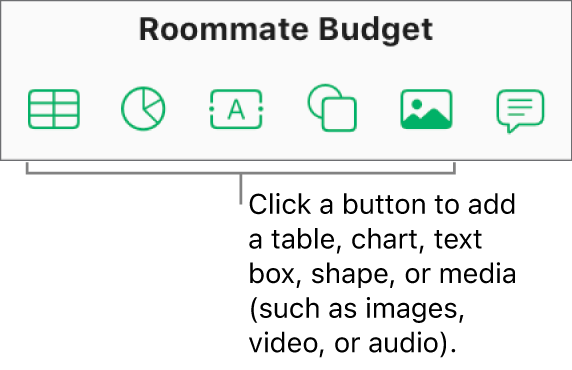
Create a spreadsheet in Numbers for iCloud
To create a new spreadsheet, you first choose a template to use as a starting point. Templates use coordinated fonts and colors for a unified look, and often include placeholder elements that you can replace with your own content.
Go to Numbers for iCloud
 , then sign in to your Apple Account (if necessary).
, then sign in to your Apple Account (if necessary).In the document manager, click
 in the toolbar.
in the toolbar.Note: If you’d like the ability to format table and chart data using the conventions of another language, choose a different language in the top-left corner before choosing a template in the next step. For more information, see Create a spreadsheet with the formatting of a different language.
In the template chooser, browse the templates by category, then double-click the one that looks closest to what you want to create.
To narrow the choices, click a category along the top.

Do any of the following:
Add data (for example, text, numbers, or formulas) to a blank spreadsheet: Click a cell, then type. To add a formula, click a cell, type an equal sign (=), then choose a formula from the Functions Browser in the Format
 sidebar on the right. For more information, see Add formulas.
sidebar on the right. For more information, see Add formulas.Edit data: To replace placeholder data (text or numbers that come with a template), select the cell, then type. To edit data you added, select the portion you want to change, or select the cell (to edit all its content at once), then type. To edit a formula, select the cell, then make your changes to the formula that appears below the toolbar. For more information, see Change an existing formula.
Format data: To format numbers, select the cell, click Data near the top of the sidebar, then make your choices. To format text, select the text (or select the cell to format all the text in the cell), in the Format
 sidebar on the right, click Cell near the top of the sidebar, then make your choices.
sidebar on the right, click Cell near the top of the sidebar, then make your choices.Add new tables, charts, text boxes, or other objects: Click an object button in the toolbar. See Intro to tables, charts, and other objects.
Note: To add a chart, you must first have a table in your spreadsheet that contains the data that the chart will display. See Create or delete a chart in Numbers for iCloud.

Edit chart data: You need to edit the table containing the data for the chart. Click a table cell, then enter your own data. The chart updates automatically.
Add or delete a sheet: To add a new sheet, click
 in the upper left. You can add multiple sheets (or tabs) to a spreadsheet to help you better organize your information.
in the upper left. You can add multiple sheets (or tabs) to a spreadsheet to help you better organize your information.To delete a sheet, Control-click the tab for the sheet at the top of the spreadsheet, then choose Delete Sheet.
Replace images: Select the image you want to replace, click Image at the top of the Format
 sidebar, then click Replace. Browse to find a new image, then double-click it.
sidebar, then click Replace. Browse to find a new image, then double-click it.Undo or redo a change: Click
 or
or  in the toolbar.
in the toolbar.Enlarge (zoom in) or reduce (zoom out) your overall view of a spreadsheet: Click the Zoom pop-up menu in the toolbar, then choose an option.

To name your spreadsheet, click the current name at the top of the spreadsheet, type a new name, then press Return (on a Mac) or Enter (on a Windows device).

Numbers for iCloud automatically saves your changes as you work, so you don’t need to worry about saving your spreadsheet manually. However, it’s a good idea to rename your spreadsheet so you can easily find it the next time you want to work on it.
To close the spreadsheet, move the pointer over the spreadsheet title in the browser tab (above the spreadsheet), then click the X that appears on the left.